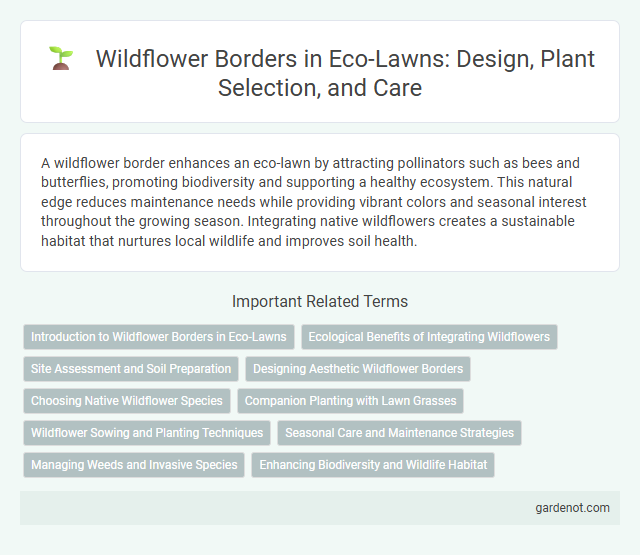A wildflower border enhances an eco-lawn by attracting pollinators such as bees and butterflies, promoting biodiversity and supporting a healthy ecosystem. This natural edge reduces maintenance needs while providing vibrant colors and seasonal interest throughout the growing season. Integrating native wildflowers creates a sustainable habitat that nurtures local wildlife and improves soil health.
Introduction to Wildflower Borders in Eco-Lawns
Wildflower borders in eco-lawns enhance biodiversity by providing habitat and food sources for pollinators such as bees and butterflies. These borders consist of native wildflower species adapted to local climates, reducing the need for irrigation and chemical inputs. Integrating wildflower borders increases soil health, supports wildlife, and creates visually appealing, sustainable landscapes.
Ecological Benefits of Integrating Wildflowers
Integrating wildflowers into an eco-lawn's border enhances biodiversity by providing essential habitats and nectar sources for pollinators such as bees, butterflies, and native insects. These wildflower borders improve soil health through natural organic matter deposition and root systems that reduce erosion and promote moisture retention. The increased ecological resilience supports a balanced ecosystem, aiding natural pest control and reducing the need for chemical interventions.
Site Assessment and Soil Preparation
Wildflower border success depends on thorough site assessment, evaluating light exposure, soil type, drainage, and existing vegetation to select suitable native species. Soil preparation involves removing invasive weeds, loosening the soil to improve aeration, and incorporating organic matter to enhance fertility and moisture retention. Proper site assessment and soil amendment optimize conditions for wildflower establishment and long-term growth.
Designing Aesthetic Wildflower Borders
Designing aesthetic wildflower borders for eco-lawns involves selecting a diverse mix of native wildflowers that bloom at different times, ensuring continuous color and pollinator support throughout the growing season. Incorporating plants with varying heights, textures, and complementary colors creates a visually appealing and dynamic border that enhances biodiversity. Proper soil preparation and maintenance, such as minimal mowing and avoiding chemical fertilizers, promote healthy growth and sustainability of the wildflower border in eco-lawn landscapes.
Choosing Native Wildflower Species
Selecting native wildflower species for an eco-lawn wildflower border supports local biodiversity and ensures better adaptation to regional soil and climate conditions. Native plants such as Echinacea purpurea, Asclepias tuberosa, and Rudbeckia hirta attract pollinators like bees and butterflies, enhancing ecological balance and garden resilience. Incorporating a diverse mix of native wildflowers promotes year-round bloom cycles and reduces maintenance needs compared to non-native alternatives.
Companion Planting with Lawn Grasses
Wildflower borders enhance eco-lawn biodiversity by supporting companion planting with lawn grasses such as Festuca rubra and Poa pratensis, which improve soil health and promote natural pest control. Selecting native wildflowers like Achillea millefolium and Centaurea nigra alongside these grasses ensures a resilient ecosystem that conserves water and reduces chemical inputs. This symbiotic planting strategy fosters pollinator habitats while maintaining a low-maintenance, drought-tolerant lawn environment.
Wildflower Sowing and Planting Techniques
Wildflower sowing and planting techniques in eco-lawns emphasize soil preparation, seed selection, and timing for optimal growth. Soil should be well-drained and lightly disturbed before sowing native wildflower seeds to enhance germination rates. Planting in late fall or early spring aligns with natural growing cycles, ensuring robust wildflower borders that support biodiversity and require minimal maintenance.
Seasonal Care and Maintenance Strategies
Wildflower borders in eco-lawns require seasonal care strategies such as targeted weeding in spring to prevent invasive species from outcompeting native plants. Mid-season mowing after seed set encourages healthy regrowth while maintaining biodiversity by preserving pollinator habitats. Autumn mulching with organic materials enhances soil fertility and moisture retention, supporting robust wildflower development for the following growing season.
Managing Weeds and Invasive Species
Effective management of weeds and invasive species in a wildflower border involves regular monitoring and timely removal to preserve native biodiversity. Applying mulch and selective hand weeding reduces competition for resources, promoting healthy growth of desired wildflowers. Introducing native plant species adapted to local conditions helps suppress invasive growth naturally while enhancing ecosystem resilience.
Enhancing Biodiversity and Wildlife Habitat
Wildflower borders in eco-lawns significantly boost biodiversity by providing diverse nectar sources that attract pollinators such as bees, butterflies, and hoverflies. These native plants create essential habitats for birds, small mammals, and beneficial insects, promoting a balanced ecosystem. Establishing a wildflower border enhances soil health and supports natural pest control, contributing to sustainable lawn management.
Wildflower border Infographic

 gardenot.com
gardenot.com